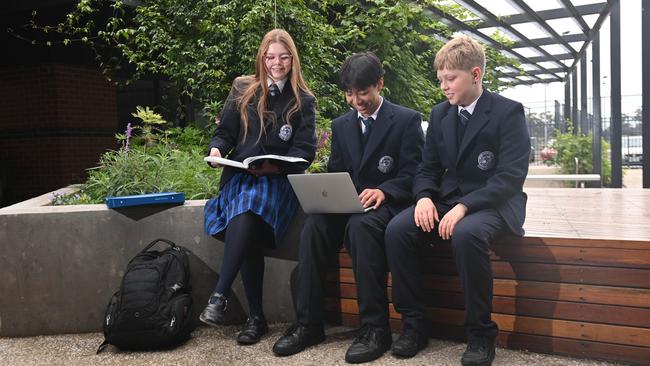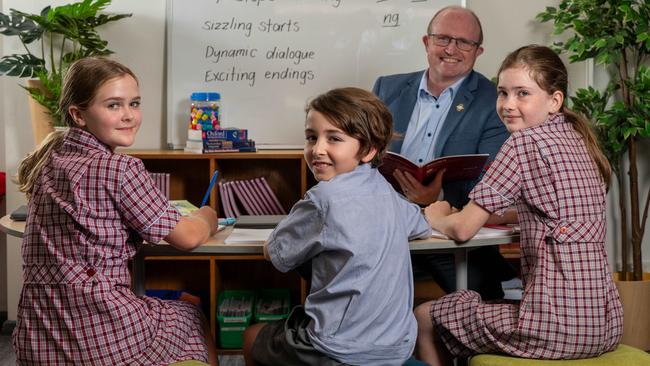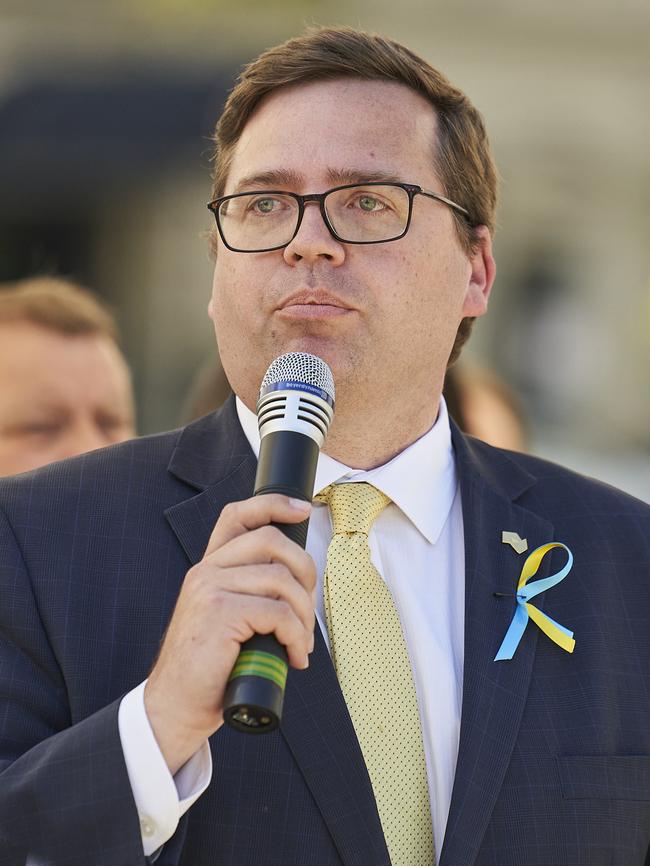NAPLAN 2023 results: How SA schools fared in annual literacy, numeracy tests
We’ve pulled together the 2023 NAPLAN results for every school in the state. See the top-performing schools and search our interactive to see all the results in your area.
SA News
Don't miss out on the headlines from SA News. Followed categories will be added to My News.
Students from Lucindale to Mt Barker and Whyalla have achieved NAPLAN test results propelling their schools into the best-performing across the state.
Analysis of Year 5 and Year 9 literacy and numeracy skills at every South Australian school has revealed big improvements for smaller sites and ongoing success for the state’s largest campuses.
Among the most-improved in 2023 was Lucindale Area School, which has fewer than 200 students.
It ranked 17th out of the top 20 schools for Year 5 results – a meteoric rise from 419th last year.
Among Year 9 students, Whyalla’s Sunrise Christian School, with about 250 students, ranked 6th – surging from 72nd last year.
And Mount Barker Waldorf School, with about 340 students, rose through the ranks, from 56th in Year 9 results in 2022 to 17th this year.
Results for every public, Catholic and independent school have been released publicly online today by the Australian Curriculum, Assessment and Reporting Authority (ACARA).
Glenunga International High School, the state’s largest public school, remained in top spot among secondary schools, followed by St John’s Grammar in Belair and Heritage College in Oakden.
Among primary students, independent St Andrew’s School inched higher from fourth spot in 2022 to become the state’s best performing primary school, ahead of St Peter’s Collegiate Girls’ School in Stonyfell and Dara School in Morphettville.
There are 12 government schools and 11 private among the top 20 for Year 5 results where multiple schools recorded the same score.
While three public secondary schools ranked among the top 20 for Year 9.

Woodville High School rocketed up the rankings, from 128 last year to 72 in 2023.
The school saw almost a third of its students in the high growth category for reading (31 per cent) and numeracy (28 per cent) from Year 7 to Year 9.
Year 9 students Natasha Brice and Thor Bonesmo, both 15, were part of the successful cohort at Woodville.
They have been part of a student-led initiative to analyse their NAPLAN data and identify areas of improvement.
“Students come together to analyse the results and we make our recommendations”, Natasha said.
“Then a group of students will go to staff meeting to make these recommendations directly to teachers.”
The students called for consistency between classes and a literal approach to learning, she said.
“You know what you’re learning and why it’s important,” Natasha said.
“It really empowers us students.”
Fellow student Thor said the school’s initiatives helped him boost his scores.
“They’ve helped me overcome my challenges and make my strengths stronger,” he said.
“I improved from past years’ NAPLAN so I’m pretty happy about that.”
The school’s achievements have been the result of a concerted effort to improve scores over two years, principal Anna Mirasgentis said.
“The work that we’ve been doing around school improvement … is actually making an impact with our young people,” Ms Mirasgentis said.
“We’re really excited to see such improvement and growth.”
When she arrived at the school in 2021, she began “looking at areas for growth”.
“Our reading, writing and numeracy were three focus areas,” Ms Mirasgentis said.
“(In literacy) it was around cohesion on audience and sentence structure and for mathematics it was on multiplicative thinking, it was on number and algebra.”
The school then began “embedding literacy and learning in every classroom”, she said.
“It wasn’t just the responsibility of English and mathematics,” Ms Mirasgentis said.
“Literacy looks different in science than it does in English.”
While dreams come big at a small primary school in Adelaide’s southern suburbs, where students want to be everything from a tech company owner to a secret spy.
And their NAPLAN results back up their students’ lofty ambitions.
Pilgrim School in Aberfoyle Park, with just 160 students, has risen up the primary school rankings from 56 last year to 26 in 2023.
Year 5 student Lana, who wants to be a spy, said NAPLAN was made “very easy” by her teachers.
“My teacher made sure we knew lots of different methods to find the best way we could solve problems ourselves,” the 11-year-old said.
Her classmate, Josiah, who wants to be a tech company owner after school, said he feels “really good” about his results.
“My teacher taught me some good strategies to help answer the questions,” the 11-year-old said.
Student Ella, 11, who wants to be a teacher, said while some questions were “tricky”, practice questions eased her anxiety.

Principal Andrew Edmondson said the school’s success was, in part, due to their “passionate teachers who are committed to seeing kids flourish”.
“Over these last five years we’ve focused on … how to take a task and adapt a task to give kids success at whatever level they’re at,” Mr Edmondson said.
“A lot of schools teach to the middle.”
As a result, he said the school’s students are engaged in their learning.
“They set goals, they’re engaged and they’re motivated to improve as well,” Mr Edmondson said.
And NAPLAN co-ordinator and deputy principal Julie Wicks said the size of the school helped to focus efforts.
“We have small classes so we know the children really well and we know where the areas of struggle are,” Ms Wicks said.
The school found that reading was an area in need of improvement.
“We could see that there were certain forms of texts that the kids didn’t really perform as well when they were answering questions about it,” she said.
“We implemented some programs where students were regularly exposed to a range of text types.”
And the students have “responded very positively,” Ms Wicks said.
“We want the children to be actively engaged and find learning fun.
“We are proud of them and they’ve worked hard.”
Education Minister Blair Boyer said SA had made improvements in NAPLAN results which showed how a focus on teaching in the early years – including a phonics check in Year 1 – was making a difference.
A new maths check will be also trialled in 2024.
Mr Boyer said the government was investing in mental health and behavioural support in schools because “if students feel engaged and connected to their school, they are more likely to perform well academically”.
“We are making the investments where they matter most because improving education outcomes changes lives,” he said.
Opposition education spokesman John Gardner stressed that NAPLAN “isn’t everything but it does provide a useful insight into how our children are travelling compared to students from around our state and around Australia”.
“I encourage parents to have a look at their child’s results and reports when they look at their school’s data,” he said.


Students sat NAPLAN tests in reading, writing, spelling, grammar and numeracy in March.
The tests, brought forward from May in previous years, were all conducted online and adapted to offer students different questions depending on how they were answering.
Authorities say expectations of students were “set at a higher level than in previous years” which means scores are not directly comparable to scores from the past 14 years.
However, all schools were assessed in the same way, making their relative rankings comparable.
Reporting of the results by ACARA changed this year to place students in one of four categories – needs additional support, developing, strong (meets challenging but reasonable expectations) and exceeding – rather than the previous system of 10 bands.
Data released in August showed that across SA about one-third of students were either found to need additional support or still be developing the required skills.
Nationally, SA improved its ranking against the other mainland states in six out of 20 categories.
The biggest jump was in Year 5 reading, where SA rose from fifth among NSW, WA, Victoria, Queensland and Tasmania, to third.
More Coverage
Originally published as NAPLAN 2023 results: How SA schools fared in annual literacy, numeracy tests




